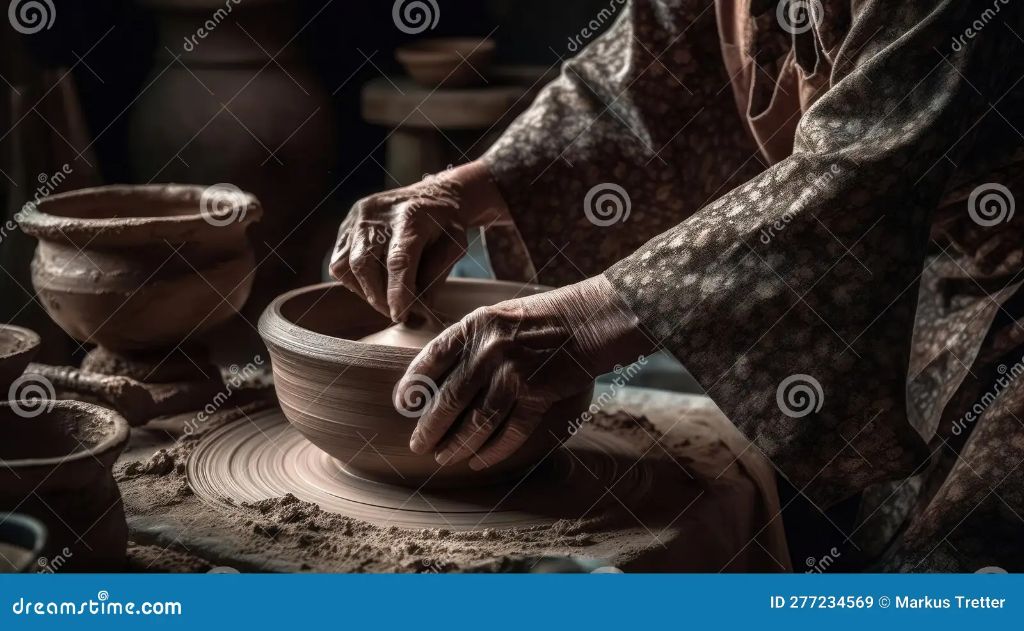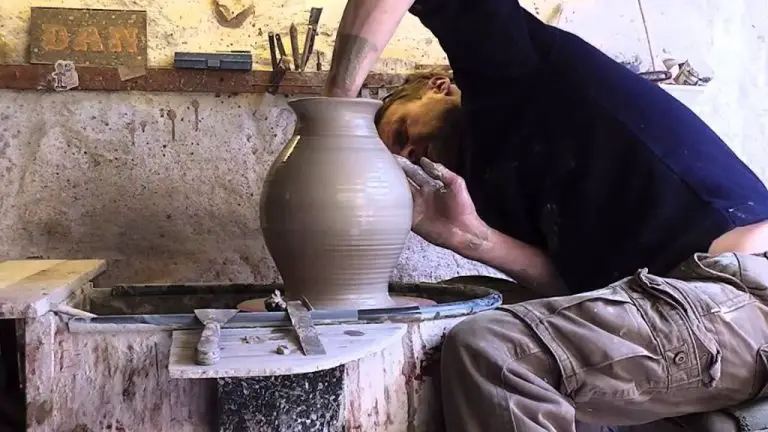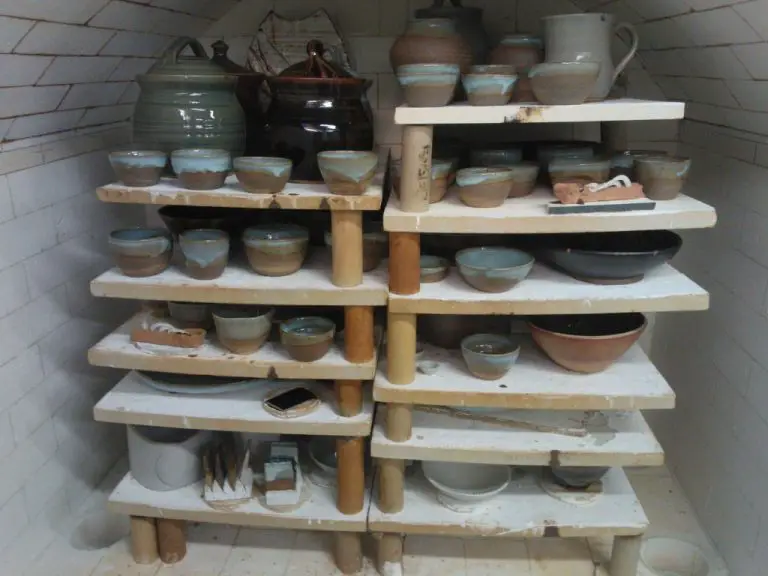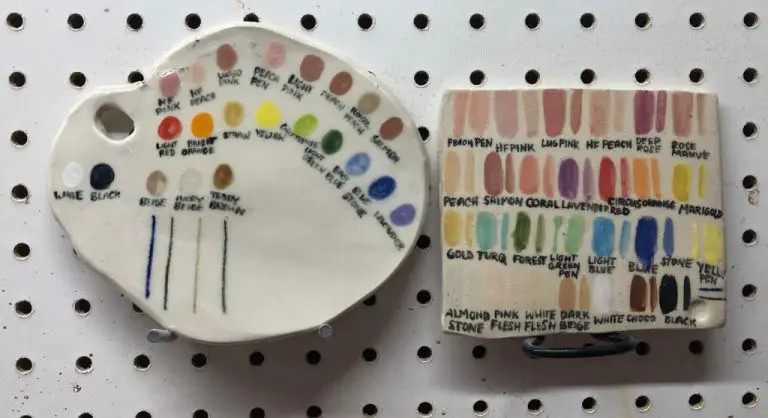What Is The Basic Tool In Pottery?
Pottery is defined as vessels and other objects made from clay, typically hardened by heat and often decorated or glazed. Pottery is one of the oldest human inventions, dating back over 25,000 years, originating with early cultures fashioning clay into simple utilitarian objects. Over the millennia, pottery evolved into an art form, with skilled artisans creating elegant works from clay.
The pottery wheel is considered the most basic and essential tool of the potter. A simple machine, the pottery wheel enables efficient and uniform production of quality pottery. Before the wheel’s invention, pottery was painstakingly made by hand using basic methods like pinching, coiling, and slab building. The wheel revolutionized how pottery was created.
Origins
The earliest evidence of pottery wheels dates back to Mesopotamia in the 4th millennium BCE. Excavations in modern-day Iraq have uncovered potter’s wheels made of stone at Sumerian sites like Ur and Uruk (Roux 2019). These early wheels were made of stone and were turned by hand. The innovation of the potter’s wheel enabled the mass production of pottery vessels with thinner walls and more uniform shapes than hand-built pieces.
From Mesopotamia, the potter’s wheel spread across the ancient world over the next few centuries. Archaeologists have found potter’s wheels dating to the Bronze Age in the Indus Valley and Elam in the 3rd millennium BCE (Roux 2019). The wheel was also adopted in Ancient Egypt around 2500 BCE and in the Aegean by 2000 BCE (Roux 2019).
While the potter’s wheel was invented in Mesopotamia, the technology was further developed in China. The Chinese developed the flywheel mechanism which uses the wheel’s momentum so that the potter can keep the wheel in continuous motion with a gentle kick. This flywheel technology, along with the invention of porcelain, enabled the mass production of high-quality ceramics in China.
Sources:
https://www.quora.com/Who-invented-the-first-pottery-wheel-and-when-did-it-happen
https://www.britannica.com/technology/potters-wheel
How a Pottery Wheel Works
At its most basic, a pottery wheel is a rotating circular platform that allows potters to shape clay into symmetrical forms with ease. The potter places a lump of clay in the center of the wheel and uses their hands, simple tools, and the forces of rotational kinetics to shape and form the clay. As the wheel spins, the potter can apply pressure to shape the clay, thinning and drawing up walls uniformly with a consistency difficult to achieve by hand building techniques.
The two key components that enable the pottery wheel to work are the flywheel and the drive mechanism. The flywheel is the rotating circular platform or wheel head that the clay sits on. The flywheel builds up angular momentum as it rotates at a constant speed. This stored rotational energy stabilizes the spinning motion and generates centripetal force, pressing the clay outwards as the wheel spins. The drive mechanism consists of an electric motor, pedal, or kick wheel assembly that spins the flywheel at a steady adjustable speed, typically ranging from 50-300 RPM.
The inertia of the spinning flywheel combined with the centripetal forces enables potters to center and shape clay into uniform symmetrical forms like cylinders, bowls, and vases through a process known as “throwing.” Without the kinetic physics of the rotating wheel, it would be much more difficult to center, raise, and shape clay with such consistency.
Sources:
https://thepotterywheel.com/how-does-a-pottery-wheel-work/
Types of Wheels
There are two main types of pottery wheels: electric wheels and kick wheels (also known as manual or treadle wheels) [1] [2].
Electric pottery wheels are powered by electricity and have a motor that rotates the wheel head. They allow you to control the speed with a foot pedal and provide consistent rotation. Electric wheels are convenient, require less physical effort, and are ideal for throwing large amounts of pottery [3].
Kick wheels, also called treadle wheels, are operated by the potter’s foot to turn the wheel head. The potter pumps a kick wheel treadle with their foot to keep the wheel head spinning. Kick wheels require more physical exertion but give the potter more control over speed. They are portable and do not require electricity [3].
Wheel Components
Pottery wheels consist of several key components that work together to enable the throwing process. Some of the main parts include:
- Wheel head – The rotating disc that the clay sits on top of. It is usually made of plaster or metal and can range in size from 10-18 inches in diameter.
- Bat – A removable plaster, wood, or plastic disc that sits on top of the wheel head to provide a smooth throwing surface. Bats protect the wheel head from wear and tear.
- Splash pan – A reservoir that sits under the wheel head to collect water and clay scraps that get thrown off during throwing. It can easily be emptied and cleaned between uses.
- Motor – Provides the power to spin the wheel head at a consistent speed. Pottery wheels usually have variable speed controls.
- Pedal – A foot pedal connected to the motor that allows the potter to start, stop, and control the speed of the wheel rotation.
- Legs – Provide stability and adjustability so the wheel can be set at a comfortable throwing height.
- Tool rest – A metal bar fixed near the wheel head where tools can be rested while throwing.
Understanding the function of each wheel component allows potters to optimize their throwing setup and techniques.
Using the Wheel
Using a pottery wheel takes practice and skill to master. Here is an overview of the basic process and techniques for using a wheel to throw pottery:
First, prepare the clay by wedging it to remove air pockets and knead it to the proper consistency. Center a lump of clay on the wheel and press down to secure it. Start the wheel spinning slowly and use your hands to center the clay and form it into a cylinder shape. Keep the wheel moving at a steady pace throughout.
To raise the walls, place your palms on the outside of the cylinder and gently push up and outward. Use the thumb and fingers of both hands to compress the clay at the top, smoothing the rim. Continue raising the walls to the desired height, while maintaining an even thickness. Go slowly to prevent the walls from collapsing.

Shape the pot by keeping one hand inside, and placing the other on the outside to refine the contour. Create curves, indents, or other decorative elements. Use a rib tool, sponge, or scraper for smoothing. When finished, use a wire tool to carefully remove the pot from the wheel head before drying and firing.
It takes practice to center the clay properly, raise uniform walls, and shape refined forms. Pay attention to keeping hands and tools moistened and wheel speed consistent. With time and persistence, using the wheel becomes easier and throwing skills improve.
Source: https://www.soulceramics.com/pages/how-to-use-a-pottery-wheel-for-beginners
Wheel Tools
Wheel throwing tools help potters shape and manipulate clay on the pottery wheel. Some essential hand tools for throwing include:
- Ribs – narrow strips of wood or rubber used to smooth and shape clay surfaces and compress clay coils when attaching parts. Ribs ensure even surfaces. Plastic ribs avoid scratching clay (1).
- Trimming tools – thin metal loops and blades on short handles for trimming excess clay from bases or altering shapes. Loop tools scrape clay and metal trimmers slice it off (2).
- Cut-off wires – nichrome wires mounted on a handle to slice clay pieces off the wheel head when completed. The taught wire slices cleanly through wet clay (3).
- Sponges – for smoothing, texturing, and cleaning clay surfaces. Sea sponges create subtle surface textures.
- Fettling knives – for cutting and trimming dry, leather-hard clay. The thin angled blades provide precision.
- Needle tools – fine metal needles for piercing holes and intricate detailing in clay.
While throwing, these standard hand tools help shape smooth bowls, plates, cups and other round shapes. They refine details and finish pieces cleanly before removal from the wheel. With practice, potters learn which wheel tools work best for their style and clay types.
Advantages of Wheel Throwing
The pottery wheel revolutionized pottery production by enabling potters to quickly and efficiently produce symmetrical vessels with uniform walls and bases. Before the wheel was invented around 3500 BCE, all pottery vessels had to be made by hand using the coil or slab techniques, which were very time consuming. With the wheel, a skilled potter can center and raise a pot in minutes compared to hours or days for hand building.
In addition to faster production, the wheel provides several key advantages:
- Consistency and uniformity – Wheel-thrown pieces have standardized sizes and symmetrical forms.
- Thinner walls – The centrifugal force of the spinning wheel allows for thinner walls than handbuilt pieces.
- Smooth surfaces – The wheel enables smoothing and burnishing as the vessel is formed.
- Versatility – The wheel allows creating a huge variety of shapes from mugs to vases.
- Decoration – Wheel pieces lend themselves to carving, slipping, glazing, etc. for decoration.
The pottery wheel enabled the mass production of high quality pottery at a scale never before possible. It allowed ancient pottery workshops to increase output and create less variable pieces. Even today, while handbuilding is still practiced, most commercial and art pottery exploits the advantages of the wheel.
Sources:
[1] https://artwheel.net/the-art-and-science-of-centering-clay-on-the-pottery-wheel/
[2] https://www.goldrattschools.org/discover-the-art-of-pottery-unleash-your-creativity-with-pottery-wheel-classes/
Wheel Throwing Styles
There are a variety of regional techniques and styles of wheel throwing that have developed over the centuries. Some of the main styles include:
- Chinese Wheel Throwing Styles: Ancient Chinese pottery focused on forms such as porcelain vases, bowls, and plates. Distinct techniques included using colored clay and glazes and intricate painted designs.
- Japanese Wheel Throwing Styles: Japanese pottery emphasizes simple, elegant forms and pristine glazes. Major techniques include Raku firing that produces random crackling.
- Korean Wheel Throwing Styles: Korean ceramics use white and grayish clay bodies accented with cobalt blue glazes. Styles include inlaid designs and vertical ridging.
- Persian Wheel Throwing Styles: Persian pottery features bright colors, calligraphy, and geometric patterns. Common forms are bowls, vases, bottles, and tiles.
- Ancient Greek and Roman Wheel Throwing Styles: Greek vases featured iconic red and black figure painting. Romans perfected pottery techniques and spread styles throughout their empire.
Modern western wheel thrown pottery blends influences from many regions and showcases both traditional and contemporary forms.
Conclusions
The pottery wheel is the basic and quintessential tool used in creating pottery. It enables potters to efficiently shape and form clay into precision ceramic pieces. While pottery can be made using only hands and simple molds, the wheel allows for much greater control and more intricate designs. It transformed pottery-making when first invented thousands of years ago, taking it from a primitive craft to an advanced art form. Even today, master potters rely on the wheel to produce their signature wares. From functional plates and bowls to decorative vases and sculptures, virtually all modern pottery involves the potter’s wheel at some stage. The wheel makes it possible to perfectly center and raise clay, thin walls evenly, and carve decorative patterns. It is an indispensable tool that has facilitated the creative expression of generations of potters across the world. For both artistry and efficiency, the wheel remains the foundation of pottery craft.





